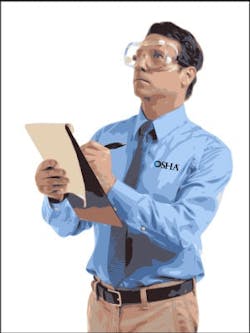Joe Marconi has a simple motto that he’s lived by every day of his career: “A day you don’t learn something is a day wasted,” he says.
Marconi has been in the repair industry for nearly 40 years. He’s owned Osceola Garage, one of the most successful shops in upper New York, for 32 years. He’s an industry consultant and is the founder of Autoshopowner.com, an online forum for repairers.
And considering his depth of experience in the auto repair industry, he was a bit surprised by what he didn’t know about his shop’s potential safety issues.
After hearing of some neighboring shops running into large citations and fines from the Occupational Safety and Health Administration (OSHA), Marconi decided to take an extra precaution for his business, and he invited inspectors for a voluntary audit of his business. It was through a service with the New York Department of Labor, and while there would be no official fines or citations from the report, the results were very real.
“I was blown away by some of the stuff,” he says. “We have always tried to stay on top of this stuff, but there were just so many things I’d never realized, things that had been that way for years.”
—Joe Marconi, owner, Osceola Garage
Marconi had three months to get the issues resolved, or else they would be reported. He fixed them—and he was surprised by how much they helped his shop.
The truth, says John Delahunt, founder of JSD Safety Services, a California-based firm specializing in these issues, is that being in OSHA compliance not only will help shops avoid fines, it allows them to operate more efficiently, increase employee productivity and improve their bottom line. And volunteering for a fine-free inspection can be a shop’s best first step.
Keep your ‘enemies’ closer
Covers on exhaust fans, power strips needing to be fixed to walls, labels on certain equipment—there were so many things that could go unnoticed, Marconi says.
In fact, Delahunt says it is impossible for shop owners to be aware of every regulation and which ones their shops are violating.
So, what’s a shop to do? Well, Marconi and Delahunt have a simple solution: Invite OSHA in. Marconi realizes this idea is about as appealing to the average shop owner as inventing self-fixing vehicles.
“I hear from people that it might draw attention or something,” he says. “Well, even if that’s true, I know now that I’m in much better shape to pass (an actual OSHA audit) than if I hadn’t done this.”
Delahunt says that, in theory, the purpose of OSHA is noble and in the best interest of businesses. It’s through the bureaucratic loopholes and human error that the system gets its bad rap.
Still, having a safe, sound workplace with solid, fundamental safety procedures helps any business, especially one like an auto repair shop. Delahunt started his career in the auto industry in the 1950s, and the majority of his clients are independent repair shops. He sees the results every day.
“The regulations make your business safer for you and your employees,” he says. “More order in a business is going to make it more productive.”
While OSHA is a federal agency, creating rules and regulations on a national level, many states have their own OSHA departments, acting as a regulatory franchise, adjusting laws and restrictions to better fit the needs of their state.
The voluntary audits can be done through private firms, such as Delahunt’s, or through OSHA itself. Those provided by OSHA are free and confidential. (Information on these inspections can be found at bit.ly/OSHAaudit.)
Breaking it down
Essentially, the voluntary inspections are carried out in the exact same way as an official audit. And those tend to center around three main facets of OSHA compliance: a safety plan, a physical walk-through of the shop and hazardous communication.
Being in compliance for each segment brings about positive changes to your shop and its productivity.
1. The Safety Plan
How it works: This can be a little more complicated than it sounds, Delahunt says, as the ones he provides for his clients come out to roughly 130 pages. However, most insurance companies provide a nice template for these. Essentially, this is a document that contains all safety requirements, procedures and details for your shop. The last part is the key here: It has to be tailored specifically to your shop’s needs; “It has to be customized,” Delahunt says.
In order to stay in compliance in regards to their plan, a shop must have it fully implemented into its business, it must have regular employee training regarding its policies, and the information must be reviewed on a regular basis.
What you learn from a voluntary inspection: Everything about your plan. No, really: “They go over the entire thing with you,” Marconi says. “They tell you what you’re missing, what looks good, what you need to do. It’s extremely helpful. I had one in place, but the tips they gave made it much more organized and helped me to learn to make sure my training and meeting and safety logs are filled out correctly and the best ways to keep them up-to-date.”
How it helps productivity: Every business is looking for ways to streamline procedures; a safety plan is another way of doing that, Marconi says. Not only does it help employees to know what to do in various situations, but it also helps the training and education process. Because he better knows what to educate his staff on, Marconi says, less time is wasted in fruitless sessions. Also, because the plan is accessible to employees, it can cut down issues of confusion.
2. The Inspection
How it works: This is the nerve-wracking part—at least, when it’s for real. The inspector will do a full, on-site evaluation of everything in your shop, looking “in every little nook and cranny for anything they can find,” Marconi says. They point out items that need to be fixed, items that are done correctly, and what needs to be done to the defective areas to bring them up to code. In all, the inspection and post-inspection discussion took roughly four hours, Marconi says.
What you learn from a voluntary inspection: Everything. Marconi says he was shown things he had never noticed, like an incorrect hookup for a water heater—that was installed 20 years ago. They also went over how items were labeled and how safety features were displayed in the shop.
How it helps productivity: Simply put: It cleans up your shop. “The more order you have in your shop, the more productive you are,” Marconi says. “You’re not wasting time looking for things, you’re not tripping over things. Things are in place. You have a system where you’re putting equipment back and tools back. You have a system where it’s all right there. You’re not tripping over airlines. That definitely increases the productivity and efficiency of a shop without a doubt.”
3. Hazardous Communication
How it works: This actually works in connection to the other two areas of the inspection. As Delahunt defines it, hazardous communication refers to “an ongoing, truthful, two-way communication line between company owners and employees regarding hazardous products in the shop.” This is done through the safety plan, the training involved and actual day-to-day work.
What you learn from a voluntary inspection: At Marconi’s audit, he says, the inspector went over the best ways to teach this to employees and how certain items were labeled in his shop. OSHA has a list of more than 400 hazardous materials found in products, Delahunt says, and each product containing such materials must be labeled and handled accordingly.
How it helps productivity: Marconi says that, while his shop already did a solid job of this, reviewing it reminded him of how important it is to stay on top of it in his shop. Keeping these materials handled correctly develops more standard procedures in the shop, and as he said before, that leads to productivity. “My guys know what to do now if, say, a gas tank ruptures,” he says. “They know exactly what to do to get it cleaned up. They’re not going to be standing around and leaving things on the floor or anything like that. And that saves everyone time.”
Safer means happier
Overall, Delahunt says, the thing to remember about OSHA is that they are—at least “in theory,” he says—there to make sure your employees are safe. That’s something every shop should appreciate on some level.
Marconi says that, since that voluntary audit, he is much more conscious of his employees’ actions in the shop: Goggles must be worn, oil slicks cleaned up. And he hasn’t seen a pushback from employees; no one’s been groaning about the extra caution or regulations.
“Honestly, I think they realize why I’m doing it,” he says. “I’m not being hard on them, I want to make sure my shop is a safe place for them to work. I do this stuff to help their safety, and I think they really do appreciate that. And when they’re happy and feel looked after, they’re going to perform better.
About the Author

Bryce Evans
Bryce Evans is the vice president of content at 10 Missions Media, overseeing an award-winning team that produces FenderBender, Ratchet+Wrench and NOLN.
